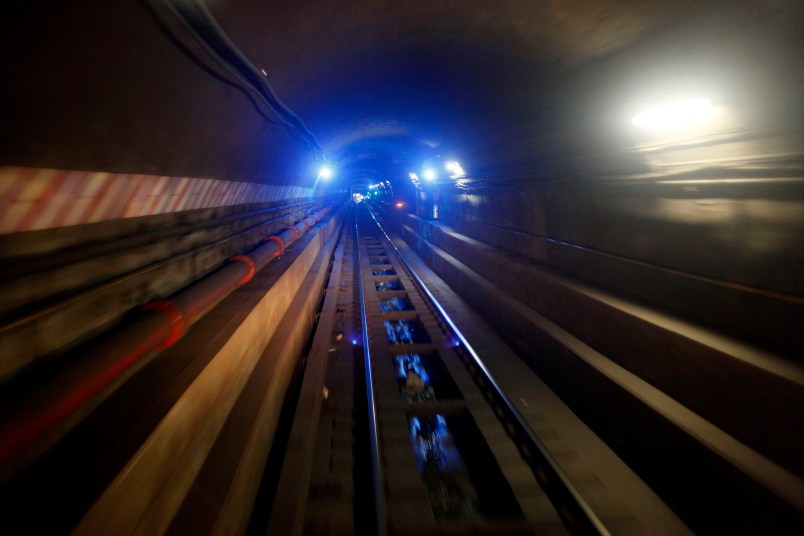NEW YORK (AP) — Longtime New York City subway cops have seen copper thefts before, but last week’s heist on a stretch of open-air tracks was particularly brazen: 500 feet of inch-thick cable stripped from the rails in the middle of the night.
The theft that shut down parts of the subway’s biggest lines and snarled the commute for 100,000 people is only the latest example of a troubling trend on the nation’s railways linked to the soaring price of copper.
“This is a money-making crime,” said Chief Joseph Fox, commander of the New York Police Department’s Transit Bureau. “It’s economy-driven.”
Copper, which now hovers at $3 a pound on the scrap market compared to about 80 cents a decade ago, is essential to the running of commuter railways, carrying electrical power from substations to the live third rail.
But the lure of easy cash at scrapyards has proved tempting to thieves willing to venture onto the tracks, risking electrocution and the safety of unsuspecting passengers.
In California, thieves removed copper from San Francisco’s BART rail system in Oakland, San Francisco and San Mateo counties on a single weekend in 2011. In Washington state in 2013, a man clipped 70,000 pounds of copper wire from the light rail tracks south of Seattle. That same year, some telecommunications linemen at New York’s Long Island Rail Road made off with $250,000 worth of copper in 56 thefts.
Insurance claims for metal thefts across the country have skyrocketed from about 13,000 from 2006 to 2008 to about 25,000 in 2009 through 2011, according to the National Insurance Crime Bureau, which tracks such thefts, though not specifically for rails. Nearly 96 percent of the more recent claims were for copper.
Along New York City’s 840 miles of subway tracks, there have been a dozen such rail thefts in the past year.
In the May 26 heist in the Howard Beach section of Queens, the rubber-shrouded cable had an estimated combined weight of 1,500 pounds that could fetch about $4,500.
New York transit police would not speculate whether the caper could have been an inside job but it appeared to have been pulled off over at least a couple of nights by people who had enough knowledge of the system to avoid getting caught or “fried.”
They targeted a stretch of track not covered by security cameras, next to a parking lot. Investigators found a hole in the fence they believe the thieves may have used to enter the tracks, then to flee. The culprits also apparently tampered with a nearby electrical box.
Sgt. Kevin Cooper, a veteran investigator on the case, said trains didn’t stall immediately because redundancy in the power system allows them to keep moving for possibly another day after copper is removed.
There are other risks. If electrical current can’t complete a circuit, it will seek another route, sometimes damaging the signal system. And if a train’s brakes go into sudden, emergency mode, riders can suffer injuries.
While police seek suspects, the Metropolitan Transportation Authority that runs the subways is installing more high-intensity lighting and surveillance technology in vulnerable locations.
Fox, the transit police chief, also has created a special unit to investigate these types of thefts, with undercover officers conducting sting operations at salvage yards.
“Police used to come maybe once a month, but now it’s three or four times a month, looking for stolen copper,” said Tom Buechel, owner of Rockaway Recycling, a scrap metal outlet in Rockaway, New Jersey.
New York Sen. Charles Schumer is proposing legislation that would require scrap sellers to prove they own their scrap, and buyers to cover any purchase above $100 by check or another traceable means. He also wants to create a new federal law making it a crime to steal metal from critical infrastructure like railroads.
“It is time to put thieves who steal scrap metal from critical mass transit infrastructure, as well as homes and businesses, behind ironclad bars,” Schumer said. “Every ounce of copper or metal stolen from New York’s critical infrastructure could cause the next big commuter delay, a subway line suspension or even a disaster.”
Copyright 2015 The Associated Press. All rights reserved. This material may not be published, broadcast, rewritten or redistributed.







Copper theft was something that occurred in Russia after the collapse of the Soviet Union in 1991. Telephone lines, plumbing, and even key infrastructure. Even radioactive scrap started to show up in Estonia, which was trading the stuff on to the West.
When people are stealing copper, you have to go after the scrap traders, as almost all copper is recycled. Once the mills purchasing scrap implemented rules on scrap, the problems in Russia vanished. New copper pipe or sheeting is a different problem as the receivers of the stolen copper can simply be another construction company, like the one the materials were stolen from.
While this was a very brazen theft, on an open subway line, this is nothing new across America. Cities throughout the nation have been shouldering millions in replacing electrical transmission lines stolen on a regular basis. Thieves go so far as to have trucks mimicking utility vans so they can prep an area, then come back in the middle of the night to execute the actual theft. In my own city, we had miles worth of underground cabling stolen from one of the high-end neighborhoods, resulting in an almost million-dollar price tag to replace. My state (CA) also has some of the nations most stringent metal recycling laws to discourage just this kind of theft.